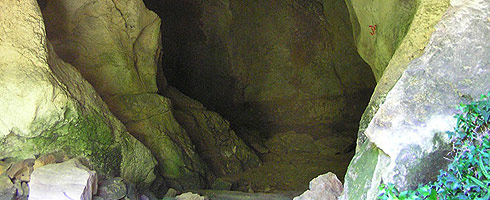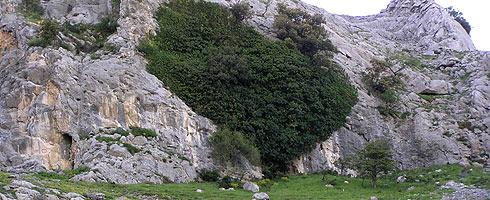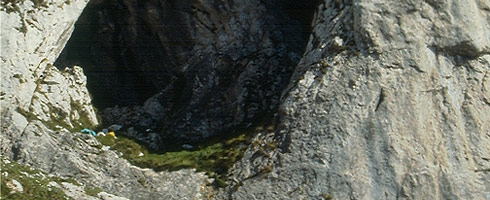Parque Natural de Urkiola · Ayuntamiento de Abadiño
Situación
Menú principal
The historiography of the reserach into Prehistoric Archaeology in Urkiola is organised into five stages, in accordance with the outline proposed by I. Barandiarán for the Prehistoria general del País Vasco (Barandiarán 1988).
The early studies into Urkiola Prehistory, up to 1917.
This initial stage is noted for the non-systematic gathering of data by some researchers (geologists, naturalists, etc.), between which there is no connection or common objectives. In the geographical setting of Urkiola, A. de Gálvez Cañero described, at the start of the 20th century, the Azkondo cave (Mañaria) and gathered some archaeological materials from the nearby Balzola cave (Dima) which he attributed to the Magdalenian, Azilian and Neolithic (Gálvez Cañero 1913).

The consolidation stage of Basque Prehistory (1917-1936).
En la comarca de Urkiola, el protagonista principal de esta segunda etapa será J.M. de Barandiarán, cuyo trabajo de campo, desarrollado entre 1922 y 1936, se resume en el calendario que exponemos a continuación.
- Archaeological dig in Mañaria (1929) during which the Silibranka shelter and the Atxuri I and Sailleunta or San Lorenzo caves were located. Materials were found in the latter which were attributed to the Magdalenian era.
- Archaeological dig at Silibranka (1930), together with T. de Aranzadi, when they prepared a Magdalenian and Azilian stratigraphy (Barandiarán 1946 and 1978).
- Archaeological dig at Abadiño (1931), during which settlements were found in Bolinkoba, Oyalkoba, Albiztei and Astakoba caves.
- Archaeological dig in Oyalkoba cave (1932), which led to a two-level stratigraphy: the lower, residential, attributed to the Bronze Age, and the upper, sepulchre, with some indications of the Late Roman period ( 4th-5th centuryDra A.D.) (Barandiarán 1950).
- Archaeological dig in Albiztei cave (1932), along with T. de Aranzadi, when human burial sites from the Eneolithic or late Bronze era were found (Barandiarán 1950).
- Archaeological dig in Bolinkoba cave (1932-1933), together with T. de Aranzadi, certifying a stratigraphic sequence from the Upper Perigordian or Gravettian to the Bronze Age (Barandiarán 1950).

The difficult years of the wars and transition period (1936 – 1953).
Due to the Spanish Civil War and the Second World War, the Aranzadi-Barandiarán-Eguren team was disbanded, along with the archaeological systematic campaigns in the Basque territory of Hegoalde.
The continuity of Basque Prehistory (1953-1970).
The leading work in the Urkiola region was yet again by J.M. de Barandiarán, together with some occasional contribution by new researchers such as J.M. Apellániz and E. Nolte.
- Archaeological dig in Mañaria by J.M. de Barandiarán (1960), where prehistoric settlements were located in the Atxuri II cave (Marcos Muñoz 1982)..
- Archaeological dig in the Atxuri I cave (Mañaria) by J.M. de Barandiarán (1960-1961), where he established a different stratigraphy where Palaeolithic materials were mixed with Eneolithic-Bronze human burial sites (Barandiarán 1962 and 1964).
- Archaeological dig in the Atxarte region by E. Nolte (1966), where signs of a prehistoric settlement were found in the Kobazarra cave (Abadiño) (Nolte and Aramburu 1965-66).
- Archaeological dig in the Albiztei cave (Abadiño) by J.M. Apellániz (1970), which ratified the existence of an Eneolithic-Bronze sepulchre site (Apellániz 1974).
The current situation of Basque Prehistory (1970-2006).
During this period, very little attention has been paid to Urkiola, with only a few isolated findings as the result of the odd archaeological digs.
- Archaeological dig in Mañaria by J.A. Martínez Vitorés (1971), which located traces of a sepulchre site in the Jentilkoba de Mugarra cave (Mañaria) (Marcos Muñoz 1982).
- Archaeological dig in Mañaria by the Deusto University Archaeological Seminary (1973), which documented trace of an archaeological site in the Kobazar II cave (Marcos Muñoz 1982).
- Archaeological dig in the Urkiola area by J. Sarachaga (1978), which catalogued the Saiputzueta dolmen (Abadiño) (Sarachaga 1979).
- Archaeological dig in the Urkiola dolmen station by J. Gorrochategui and M.J. Yarritu (1981), which located two open-air settlements at Saiitxiki and Urkiolamendi, both in Abadiño (Gorrochategui and Yarritu 1984).
- Demarcation of the archaeological filling in of the Asuntze site (Abandiño) by Aguirre Ruiz de Gopegui and Juan Carlos López Quintana (2000), which established a stratigraphic sequence attributable to the middle Palaeolithic era (Aguirre and López Quintana 2000).

2006 - 2007 © Anteiglesia de Abadiño Town Council - All rights reserved